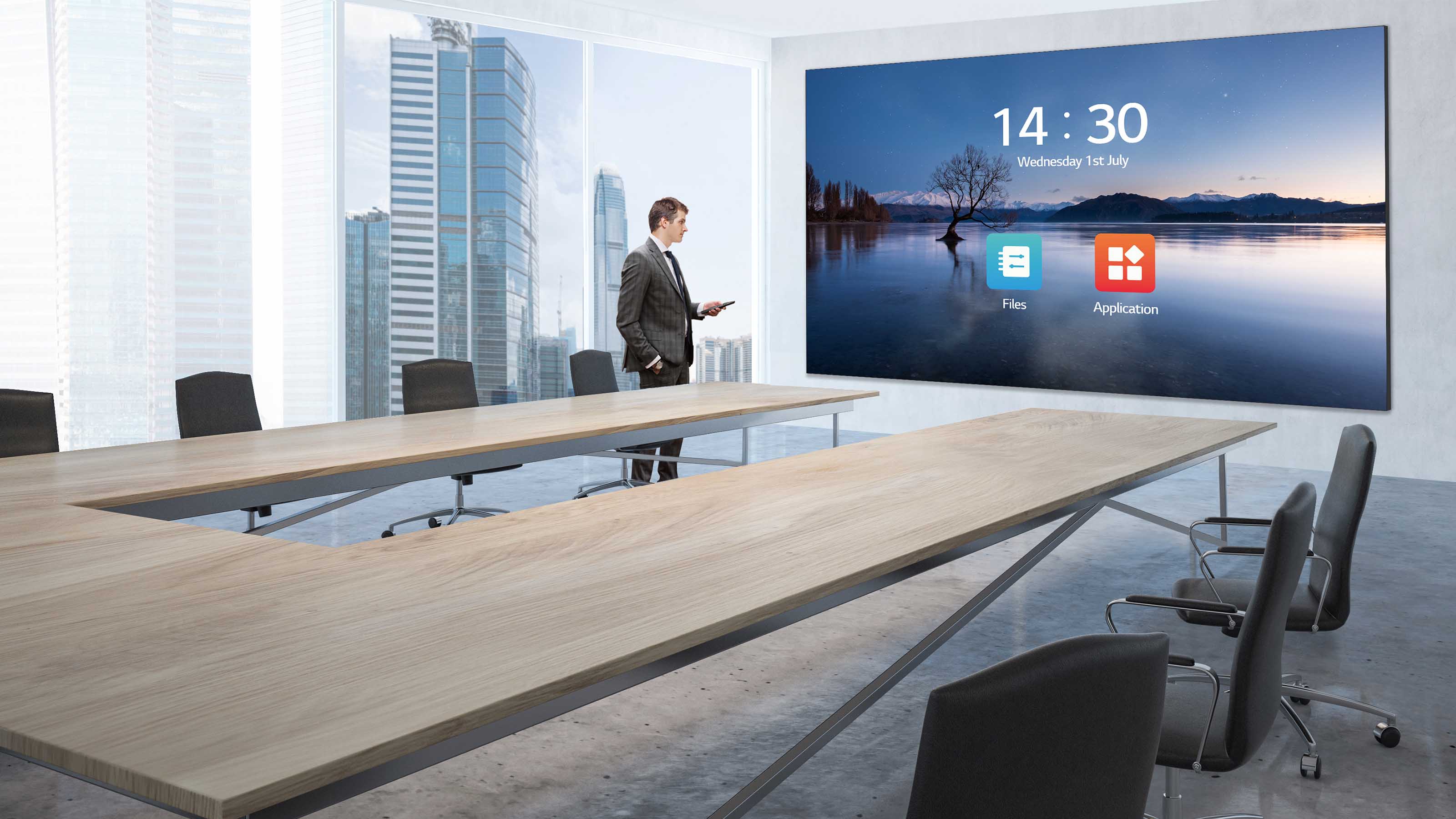A couple of years into the post-pandemic era of the workplace one thing has been made clear: The hybrid model is here to stay. However, that doesn't mean that all remote workers are thrilled with the technology behind it. That makes creating the perfect conference room for in-person and remote participants pivotal to employee satisfaction and productivity.
[The Integration Guide to Video Displays and Mounts]
What is the best display for a conference room? Should you go with an LED panel or video wall, and which aspect ratio is best to accommodate all participants in the room or offsite? We asked some Pro AV experts what to look for when picking out the right solution to make videoconferencing and presentations inclusive for every participant.
Unique Advantages
Simply put, whether an integrator goes with an LED panel or a video wall depends largely on both the size of the room and the budget. While those are among the first two considerations, there are plenty of others.

"Consider the type of content that will be displayed," said Rob Meiner, technical sales engineer at Peerless-AV. "If presentations or content require a specific size or resolution, this could factor into which choice would be best. Something else to consider is how the display will integrate with existing AV equipment, videoconferencing systems, and control systems. Ensure the chosen solution is compatible with established infrastructure to allow for seamless use.
"The physical layout of the room also plays a role," he continued. "Envision how the display will fit within the room's design and whether it will obstruct viewing or interfere with the room’s acoustics."
Another consideration is whether an LED panel or video wall is more advantageous, because both have their positives. "The advantages for single-panel LEDs are that they are bezel-less, easy to install, have no calibration complications, and are easy to maintain due to front serviceability," explained Victoria Sanville, director, corporate and public sector sales at LG Business. "These single-panel LEDs also have image quality that supports the ability to view typical spreadsheet and PowerPoint style office content without the distraction of bezels or improperly calibrated or aligned video wall displays. Logistically speaking, LED panels are much simpler to transport and set up, as they can be broken down into parts and set up in kits."
[A Business-Focused Product Showcase: Welcome to LG’s New Headquarters]
"dvLED video walls also present their own unique advantages," Meiner added. "They offer flexibility, adapting to various spaces and layouts, making them suitable for many conference rooms. Video walls provide superior image quality, color uniformity, and brightness, even in well-lit environments. The scalability of this type of display is a key strength, enabling users to expand the display by adding more panels as needed."
Terence Migas, AV design engineer at Solutionz, added that video walls also have the advantage of an array of available mounting options, including curved and corner panel options.

"Single-panel displays are undeniably more accessible [due to budget], and that is a significant advantage," said Musfik Dogancay, executive director at JKL Technologies. "While there are size limitations for larger spaces, they are large enough for many conference rooms. Their ubiquity also makes them easy to physically install and support since they don’t require specialized skillset.
"Video walls," he continued, "provide larger images, but selection of the right product—dot pitch, for example, is critical for applications where the users are close to the image—is important. The size of the room and size of image required is the most important criteria, as video walls have a larger entry cost, require more specialized installation labor, and support needs to be planned in advance to avoid replacement challenges later. In many cases, in conference room spaces, video wall brightness needs to be turned down significantly reducing their usefulness."
Don’t Get Ratioed
While 16:9 is the widescreen standard for videoconferencing displays, the 21:9 aspect ratio is growing in popularity and is certainly one of the latest trends. So, is there a "right answer" in finding which aspect ratio is best? There is no one-size-fits-all answer, but there are factors to consider.

"I continue to advocate for the use of the 16:9 aspect ratio," Migas said. "However, I believe that as more people become aware of the benefits and options offered by 21:9 displays, there will be a growing demand for them. I apply AVIXA's recommended standards to determine the optimal display size. In the case of a video conference room, I typically opt for a size slightly larger than the standard recommendation. However, when using a 21:9 display, I do not choose a larger size, since it provides screen space for the far side participants."

"We always start with a discovery session or site walk to determine how a customer is using the space they want to deploy the technology in, as every space and every customer is unique," Sanville said. "We’re definitely seeing a trend of customers leaning toward 21:9 displays, as it is particularly compatible for those who use Microsoft Teams. We are also seeing customers utilize 21:9 for other applications where wide viewing angles are required. Overall, 21:9 seems to be the preferred display ratio these days."
[On Visualization Technologies: Peerless-AV]
What is it about the 21:9 aspect ratio that makes it so appealing for conference rooms? “The 21:9 aspect ratio offers additional horizontal screen space, making it beneficial for presentations featuring wider content,” explained Meiner. "This includes panoramic images, expansive spreadsheets, and the ability to display multiple side-by-side windows, enhancing the viewer's immersive experience. It is particularly well-suited for creative and design-focused presentations, where the broader canvas allows for greater artistic expression.”
Mount Up
Once the decision is made on which solution suits the conference room best, the next step is to get the displays installed. Migas is quick to point out that the space requirement for a video wall is dependent on AVIXA's recommended standards and aspect ratio of the view wall.
Dogancay recommends articulating arms for both ease of installation and maintenance. "Single panels are starting to push the limits at 85 inches on an articulating arm," he said. "Typically, we see displays up to 65 inches on articulating arms for day-to-day use, and anything above 65 inches are on articulating arms for maintenance purposes. There is significantly more hardware being mounted behind displays in the last few years and accessing them—especially behind larger displays—gets harder."
“We’re definitely seeing a trend of customers leaning toward 21:9 displays, as it is particularly compatible for those who use Microsoft Teams.”
Victoria Sanville, LG Business
One of the latest trends are all-in-one displays. For LG, if an all-in-one display is the solution, the sky is the limit. But it isn't simply the size of the screen, but also the space available that needs to be examined.
"When it comes to single panel mounting, there are really no restrictions," Sanville said. "All-in-one single LED panels can be mounted on the wall or on a movable stand, and it’s possible to accommodate displays of any size requested by the customer. A single mount can be used for screen kits up to 217 inches.
"The amount of physical space needed around the display varies depending on the product," she added. "For standard LED systems, we generally recommend leaving a minimum of 3 inches of clearance around the outer edges of the screen to allow for proper installation and heat dissipation. However, some products, like LG all-in-one displays, need additional space due to their unique wall mounting method."
[SCN Hybrid World: How to Make Room Scheduling Easy]
Video walls tend to be larger, thus space and mounting require extra attention. “The space required for a video wall installation is contingent upon the specific attributes of the video wall, the room's layout, and the envisioned purpose,” Meiner said. “Effective integration into the space and fulfillment of its intended role requires professional guidance and meticulous planning. It's imperative that the space not only accommodates the physical dimensions of the video wall but also ensures an optimal viewing experience for the audience.”

